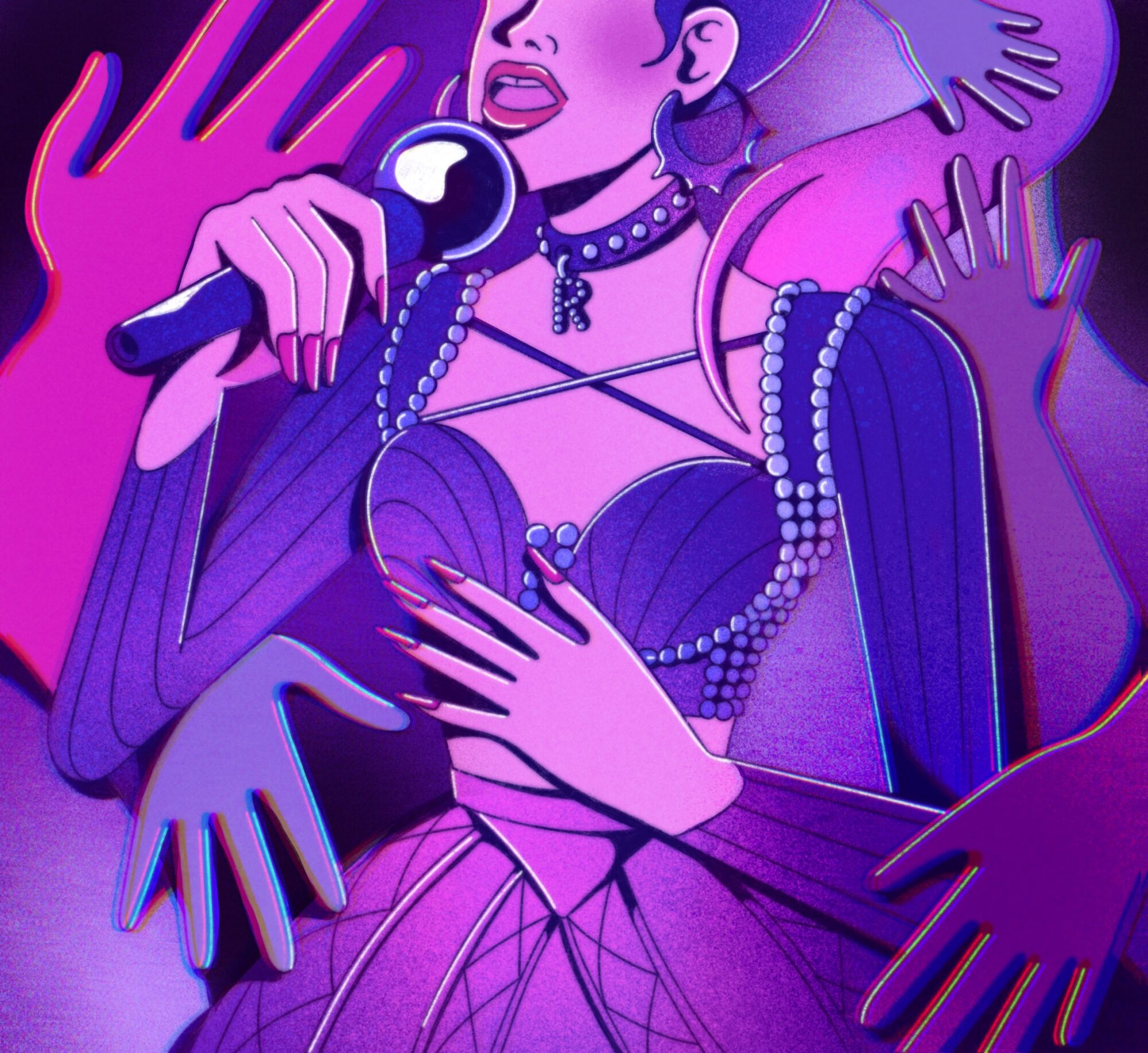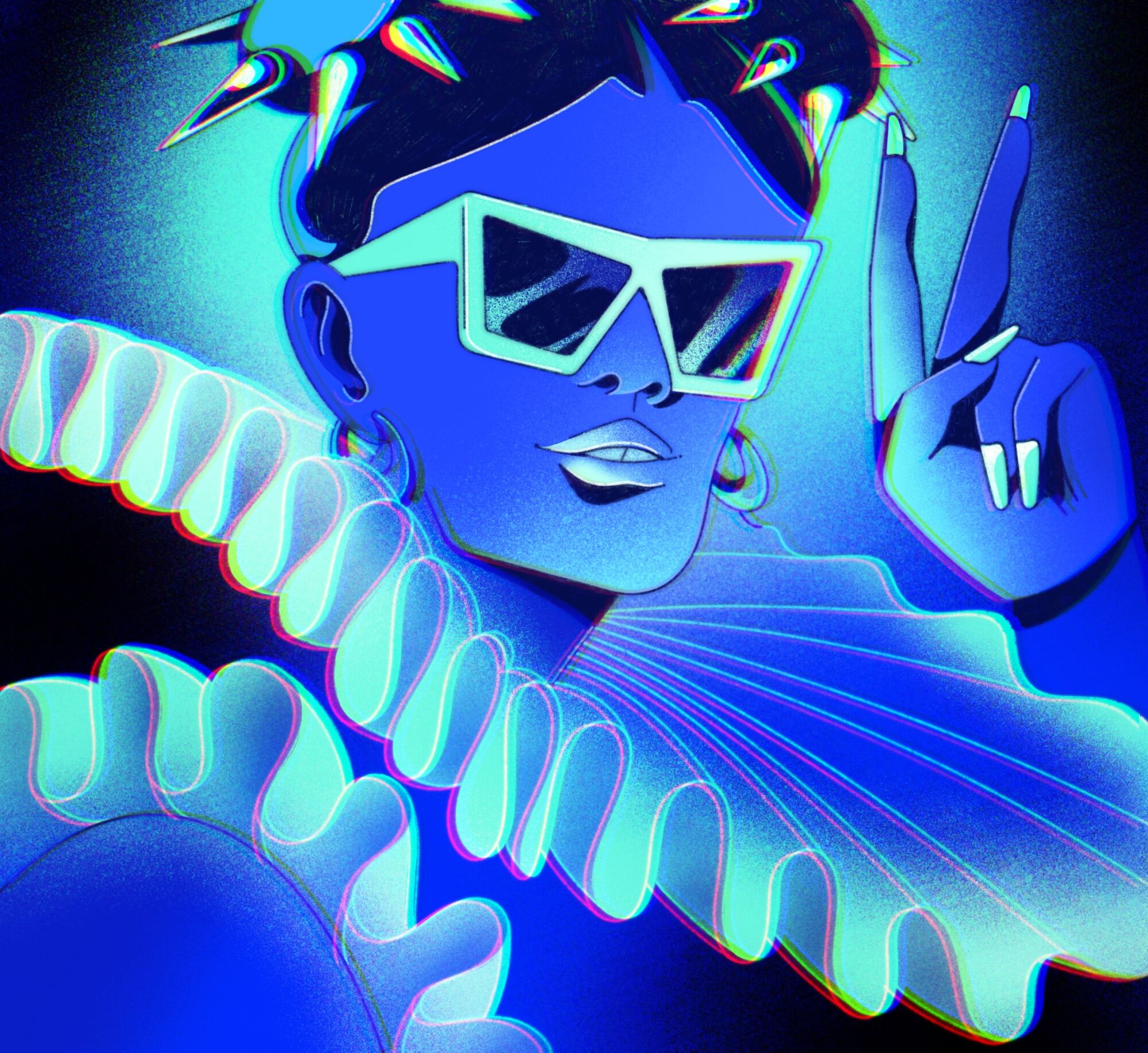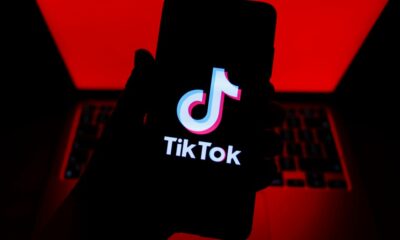SOCIAL
How fan videos made ‘Six’ the musical a hit on Broadway, beyond

“Get your phones out — you’re gonna wanna film this!”
In the theater world, the sentiment would normally be a form of sacrilege. It’s distracting to actors onstage. It impedes the view of fellow audience members. It’s antithetical to the immediate, communal, ephemeral nature of the art form.
But with “Six,” the scintillating stage show that reimagines the wives of Henry VIII as a chart-topping girl group, it’s practically a requirement, kicking off a closing number written specifically to be recorded and shared on social media.
Audiences film while dancing by their seats, singing along and cheering with excitement. Spotlights swoop from side to side. Confetti falls from above. And each of the six actors — dressed in jewel-toned Tudor fits, fishnet stockings and bedazzled boots — reprise the catchiest sections of their characters’ signature songs for the crowd and their phones. The “Megasix,” as the number has come to be called, turns musical theater into a full-on pop concert.
The three-minute arrangement has helped transform a scrappy Edinburgh Fringe Festival act with no set changes, no intermission and no stars into an international phenomenon, capturing the attention of an elusive demographic in ways theatrical producers usually only dream of.
“Like a lot of ‘Six,’ that was not intended to be a huge, colossal thing,” said the show’s co-creator Toby Marlow. “We really were not thinking, ‘How can we take over social media with Megasix videos?’”
Evolving from a mellower medley attempted after the production’s 2017 debut, the Megasix picked up its defining feature from producer Kenny Wax. His suggestion that viewers record the number was both a dramaturgical choice and a form of affordable grassroots marketing.
“Our show is supposed to feel like a pop concert,” said “Six” co-creator Lucy Moss. “So getting people filming made sense because it’s within the genre, it’s connected inherently to the concept.”
Soon enough, attendees began to post their footage online, forging community with other “Six” fans, supporting the show’s revolving door of actors and promoting the cause of theater accessibility amid high ticket prices and, later, COVID-19 risks. A number of actors also embraced it as a digital souvenir, one that preserves their onstage successes and snafus and allows fans to feel more connected to performers than ever before.
On Facebook, Twitter, YouTube, Instagram and TikTok — at the time a nascent social media platform gaining steam with Gen Z users — the proliferation of Megasix clips teased “Six” as a musical with a hypervisual aesthetic, self-deprecating humor and unapologetic pop sound.
“It looks like a concert but it clearly isn’t; it looks like the place to be,” said Trevor Boffone, author of the forthcoming book “TikTok Broadway: Musical Theatre Fandom in the Digital Age.” “This is not your grandparents’ musical theater.”
Each subsequent staging yielded more Megasix uploads — except in the United States, where filming the performance is against union rules. Moss and Marlow could easily have considered its burgeoning social media popularity a risk: “Most of the time, creators are a little bit hesitant getting that [intellectual property] out there without the greater context of the show,” said Jonathan Breitbart, a 20-year-old Colorado theatergoer who came across “Six” videos in late 2018 and became a fan.
Instead, in an industry still dominated by print ads and billboards, the Megasix turned into the most organic, continuous and occasionally intense social media marketing campaign in recent memory — “a form of free publicity that has allowed for a greater amount of visibility and accessibility for the show than most professional theaters can boast,” wrote Samantha Eve Marchiony in her University of Houston master’s thesis.
Tara Dawn Schwartz, 38, hadn’t heard of “Six” before watching Megasix videos while at home in Long Island, N.Y., during the pandemic. “I remember thinking, ‘I want to see this in person. I really want to see it live and hear it live and connect with this music on a new level.’”
“Six” now spans open-ended runs on Broadway and the West End, two concurrent U.S. tours, a United Kingdom and Ireland tour, two ongoing cruise line productions and a staging in Asia, plus a recently wrapped stint in Australia and performances in Canada and Holland starting later this year. And because “Six” casts its royal characters diversely across ethnicities, body types and vocal tones, “the content is continually interesting,” Boffone noted.
“They created fan-driven marketing that doesn’t really cost the show any money. People are paying to see them, and then marketing their show for them.”

(Rebekka Dunlap / For The Times)
In “Six,” which follows a competition among the queens to be their group’s lead singer based on how terrible their lives were while married to Henry VIII, the cast is onstage nearly the entire 85-minute run time — and “every single tiny little beat is very, very planned,” said Moss, who also co-directed the show.
The Megasix, by contrast, is “more about having fun with the audience,” she added. “It’s not a full free-for-all, but there are moments where [the actors] can have their bit of self-expression. You can play with intonation and rhythm, or play with a different attitude. We encourage them to do their own thing.”
After a spirited roll call of the four-person band, the cast amps up the reprise with personalized vocal riffs — provided they’ve been approved by the show’s musical director — along with spontaneous dance moves and reactions to fellow actors and the audience.
“You can’t lock it in, which keeps you on your toes,” said Gabriela Carrillo, who plays Catherine Parr on the West Coast tour. “It’s less improv and more listening and responding to each other. And even though we’re supposed to always keep moving, there are still five other people onstage. If you deviate too much from any spot you’re supposed to stand in at any moment, there will be a collision.”
“Six” fans watch Megasix videos the way sports fans catch the highlights from a winning game — even though you already know the outcome, you want to see how it happened this time. Justin Smith, a 25-year-old fan in Texas, searches daily for clips of all the ongoing productions and pays attention to the vocals — particularly, the overlapping hooks between Catherine of Aragon and Anne Boleyn, as “the Boleyns have a loose interpretation of the melody there, and the Australian cast especially riffed the heck out of it.”
Aimee Stern, a 30-year-old New York City resident, eyes the choreographic choices: Did Katherine Howard do that helicopter move with her high ponytail? How far did Catherine Parr bend backward on her big note? And Carly Baker, a 20-year-old New York City theatergoer, looks out for the actors’ interactions: the smiles, the laughs, the nudges. “It’s entertaining to watch because every day is different for them based on the energy and the camaraderie on that stage.”
This is especially true when a “Six” performance features an alternate, a circumstance celebrated in “Six” more than other productions. “Our creatives do not prefer to do what typical musical theater does with alternates, which is to do a carbon copy of what the [principal actor] has already done,” said Cassie Silva, the dance captain and an alternate on one of the show’s two concurrent U.S. tours. “In fact, it’s the exact opposite. They’re very passionate about us building our own authentic version of each queen. So when you get to see an alternate go on, it really shakes things up.”
Fans like Stern regularly buy last-minute tickets upon notice of an alternate, specifically with the intention of filming the Megasix and sharing it online. “I try to think about how happy I feel when I get to see a Megasix of somebody who I don’t think I’m gonna have a chance to see, and I try to bring that joy to fans who either can’t afford theater or maybe don’t live around where ‘Six’ is right now,” says the New York City resident. “Of course, it’s not the full show, and it’s not the same thing as being there. But it’s a really cool way for people to at least experience a little bit of that person’s performance as that queen.”
“Six” actors are often tagged in viewers’ Megasix uploads on social media. “[Alternates] never got professional pictures on Broadway; we never got any B-roll of us performing,” said Courtney Mack, who has covered nearly every role across multiple “Six” productions and is playing Katherine Howard on the West Coast tour. “And some of these videos that they got are really nice! There’s stuff from fans that I’m probably going to keep forever.”
The influx of Megasix clips has prompted some viewers to come back again. And again. And again. Stern has seen “Six” 89 times across five different productions. Helen Sullivan, a 23-year-old Brooklyn resident who discovered the show while studying abroad in London, has seen it 97 times in the name of “swingo,” or seeing an alternate play every queen: “I told my mom it’s cheaper than therapy.”
The videos also whet fans’ appetite for new “Six” stagings. “My friends have already sent me a Tiktok of the first Megasix with the Seoul cast,” said Marlow days after the South Korea production opened. “Seeing the view counts, [it] hit me that people are seeking out these videos.”
“I’d be interested to see what it’s like for the actors, though,” Marlow added. “I’m sure they’ll have different experiences with it because they’re the ones that are immortalized every night in these videos.”

(Rebekka Dunlap / For The Times)
So is the “Six” cast supposed to play to the in-person audience or the phones in their hands?
“Both,” said Moss. “It’s very much for everyone there, but also having those little moments with the cameras. And it’s also for the people in the room to see these famous pop-star queens playing to the cameras.”
Close-up Megasix videos feature these actor-audience interactions — another routine “Six” occurrence that would be a rarity in any other show. “As time went on and the fan base grew, I definitely got more used to putting my face in a few people’s cameras,” said Natalie Paris, who played Jane Seymour in multiple U.K. productions and is now on the show’s West Coast tour. “Once I got used to breaking that barrier, I had more fun with it and was a bit more playful.”
The clips show the cast looking directly at certain cameras, pointing, winking, smiling and dancing toward them as if they’re the only phones there. Some actors even grab a viewer’s phone for a selfie video — an idea attributed to Maiya Quansah-Breed, who played Catherine Parr when the upbeat Megasix was first added to the production.
“We want people to be hooting and hollering and cheering at this show,” noted Mack. “If you don’t have a high-energy audience, it’s hard to keep the energy up the whole time. So if there’s someone giving you their positive energy the whole time, interacting with them is almost like a thank you.”
As with any collection of fan content, not all Megasix videos are uploaded in good faith. “There are all of these comparison videos that make it an issue when someone strays from certain characterizations or how someone says a certain line,” observed longtime fan Breitbart. “Posting opinions on social media can impact the actors, they can see it all. And it’s like, is this productive? Is that really what you want to take away from that experience?”
When the decision to encourage audience filming was first made, members of the creative team told the cast that the choreography and the vocals “need to be so hot now because it’s gonna be on camera,” recalled Paris. “As a performer, what’s so special about theater is that you get to leave everything you’ve got on the stage. It’s a daunting thought to know that a lot of people can capture that moment forever and put it straight onto social media.”
The added pressure also means “Six” actors carry some reservations about the practice. “You do a mental shift because it isn’t just live theater, it’s live theater plus whoever gets to see this,” Carrillo said. “People will make a judgment about the way someone plays a character from one video, when they don’t realize it’s so much more. And if a video ever got out there where I wasn’t a perfect human being, well, I can’t control that.”
“That expectation is so much higher as an alternate,” added Silva, who likened an alternate’s Megasix debut video to a rookie player’s baseball card. Since joining the cast, Silva hasn’t been shy about asking fans to remove videos of onstage snafus. “They don’t typically post stuff if it’s bad, and if it is, they’re usually pretty decent about taking it down. I’ll reach out even if it’s of other people but doesn’t show them in the right way. Like, let’s not do that.”
Paris tries not to watch too many Megasix videos of herself — “sometimes even it comes down to a bad camera angle,” she said — and many of the “Six” actors who spoke to The Times avoid reading the comments on the uploads. “Most of the fans are pretty supportive, but somebody on Instagram once wrote in all caps ‘HORRIBLE,’” said Mack.
“I don’t care because those people are not in my position. They don’t know how hard the show is, or how heavy those costumes are. They don’t know what I’m going through mentally, physically, vocally. I could have bad allergies, I could be just recovering from a sickness. So even if it’s not our best night, they don’t know what’s going on with us at all.”

(Rebekka Dunlap / For The Times)
On Broadway and on the two U.S. tours, where filming the Megasix is prohibited, the aforementioned lyric has been changed to “Stay on your feet! I wanna see everybody clap your hands!”
That’s a tough reality to face for some audience members, especially those who might have bought a ticket specifically after watching the clips. Many sneak recordings anyway, to the dismay of ushers across the country. Others, like a number of the “Six” superfans who spoke to The Times, have been willing to travel abroad to experience the Megasix in its intended form.
“When we were asking for permission to have the filming, I was like, ‘It’s part of the show,’” said Moss. “It’s really important to respect their rules. But in some ways, it’s a shame that U.S. audiences don’t get to experience that.” Added Marlow, “There’s something nice about that audience getting the experience of watching and dancing and feeling like you’re at a pop concert in a different way.”
Such was the case for Smith who, after years of watching Megasix videos daily, finally nabbed a front-row seat for the Christmas Eve performance. “One thing I didn’t expect is just how shiny and gorgeous their costumes are up close,” he recalled.
“The energy, the confetti flying everywhere, it was amazing. And not having to squint to see their facial expressions, because they were just right there. No phones, no heads, no hands — nothing blocking my view.”

















